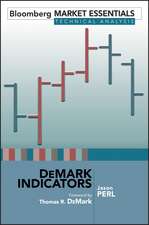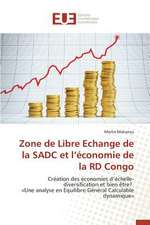An Introduction to International Capital Markets, 2e: Products, Strategies, Participants
Autor Andrew M. Chisholmen Limba Engleză Hardback – 21 mai 2009
Fully revised and updated from the hugely popular first edition, this book is an accessible and convenient one-volume introduction to international capital markets, ideal for those entering or planning to enter investment banking or asset management. As well as serving as an invaluable reference tool for professionals already working in the industry looking to extend their knowledge base it will also benefit all those working in trading, sales and support roles.
Describing how the key products and markets work, who the principle participants are and their overall goals and objectives, Andrew Chisholm provides a thorough overview of the global capital markets. The book covers a wide range of equity, debt, foreign exchange and credit instruments as well as the principal derivative products. In a step-by-step fashion, making extensive use of real world cases and examples, it explains money markets, foreign exchange, bond markets, cash equity markets, equity valuation techniques, swaps, forwards, futures, credit derivatives, options, option risk management and convertible bonds. An extensive glossary also explains concisely many of the ‘jargon’ expressions used in the financial markets.
Boasting an international focus, examples are drawn from major international markets around the world. It makes extensive use of numerical examples and case studies to help explain a wide range of cash and derivative products used in the capital markets business. It covers both debt and equity products and includes new material on credit products such as collateralized debt obligations and credit derivative structures; equity fundamental analysis, portfolio theory and convertible bonds. Market data has been fully updated from the first edition and recent events such as the ‘credit crisis’ are discussed.
Preț: 583.32 lei
Preț vechi: 634.04 lei
-8% Nou
111.62€ • 119.36$ • 93.07£
Carte tipărită la comandă
Livrare economică 17 aprilie-01 mai
Specificații
ISBN-10: 0470758988
Pagini: 448
Dimensiuni: 170 x 244 x 25 mm
Greutate: 0.91 kg
Ediția:2nd Edition
Editura: Wiley
Locul publicării:Chichester, United Kingdom
Public țintă
Investment and portfolio management new entrants and professionals, individuals who provide support services to capital market businesses, MBA finance students.Notă biografică
ANDREW M. CHISHOLM has designed, developed and taught programmes in derivatives and finance since 1984. In that time he has worked with many of the largest financial institutions around the world, teaching corporate financiers, traders, sales and marketing staff, risk managers, analysts, fund managers, operations and technology professionals. He has worked extensively on seminars at senior management level as well as training programmes designed to introduce new graduate and MBA entrants to the securities industry. He was formerly Head of Professional Development for Europe at JP Morgan and is author of Derivatives Demystified published by John Wiley and Sons in 2004.
Cuprins
Acknowledgment 1 Introduction: The Market Context 1.1 Capital and the Capital Markets 1.2 The Euromarkets (International Capital Markets) 1.3 Modern Investment Banking 1.4 The Clients of Investment Banks 1.5 About this Book 2 The Money Markets 2.1 Chapter Overview 2.2 Domestic Money Markets 2.3 US Domestic Markets 2.4 The European Central Bank (ECB) 2.5 Sterling Money Markets 2.6 The Bank of Japan 2.7 Systemic Risks and Moral Hazards 2.8 Treasury Bills 2.9 Discounting Treasury Bills 2.10 US Commercial Paper 2.11 Credit Risk on USCP 2.12 Bankers' Acceptances 2.13 The Eurocurrency Markets 2.14 Eurocurrency Loans and Deposits 2.15 Eurocurrency Interest and Day-Count 2.16 Eurocurrency Certificates of Deposit 2.17 CD Yield-to-Maturity 2.18 Euro-Commercial Paper 2.19 Repos and Reverses 2.20 Repo: Case Study 2.21 Other Features of Repos 2.22 Chapter Summary 3 The Foreign Exchange Market 3.1 Chapter Overview 3.2 Market Structure 3.3 FX Dealers and Brokers 3.4 Spot Foreign Exchange Deals 3.5 Sterling and Euro Quotations 3.6 Factors Affecting Spot FX Rates 3.7 Spot FX Trading 3.8 Spot Position Keeping 3.9 FX Risk Control 3.10 Cross-Currency Rates 3.11 Outright Forward FX Rates 3.12 Outright Forward FX Hedge: Case Study 3.13 Forward FX Formula 3.14 FX or Forward Swaps 3.15 FX Swap Two-Way Quotations 3.16 Chapter Summary 4 Major Government Bond Markets 4.1 Chapter Overview 4.2 Introduction to Government Bonds 4.3 Sovereign Risk 4.4 US Government Notes and Bonds 4.5 US Treasury Quotations 4.6 US Treasury Strips 4.7 Bond Pricing 4.8 Pricing Coupon Bonds: Examples 4.9 Detailed Bond Valuation: US Treasury 4.10 Bond Yield 4.11 Reinvestment Assumptions 4.12 Annual and Semi-Annual Bond Yields 4.13 UK Government Bonds 4.14 Japanese Government Bonds (JGBs) 4.15 Eurozone Government Bonds 4.16 Chapter Summary 5 Bond Price Sensitivity 5.1 Chapter Overview 5.2 Bond Market Laws 5.3 Other Factors Affecting Price Sensitivity 5.4 Macaulay's Duration 5.5 Calculating Macaulay's Duration 5.6 Duration of a Zero 5.7 Modified Duration 5.8 Price Value of a Basis Point 5.9 Convexity 5.10 Measuring Convexity 5.11 Convexity Behaviour 5.12 Portfolio Duration 5.13 Dedication 5.14 Immunization 5.15 Duration-Based Hedges 5.16 Convexity Effects on Duration Hedges 5.17 Chapter Summary 6 The Yield Curve 6.1 Chapter Overview 6.2 Real and Nominal Interest Rates 6.3 Compounding Periods 6.4 The Yield Curve Defined 6.5 Theories of Yield Curves 6.6 Zero Coupon or Spot Rates 6.7 Bootstrapping 6.8 Spot Rates and the Par Curve 6.9 Pricing Models Using Spot Rates 6.10 Forward Rates 6.11 Discount Factors 6.12 Chapter Summary 7 Credit Spreads and Securitization 7.1 Chapter Overview 7.2 Basics of Credit Spreads 7.3 The Role of the Ratings Agencies 7.4 Credit Spreads and Default Probabilities 7.5 Credit Default Swaps 7.6 Index Credit Default Swaps 7.7 Basket Default Swaps 7.8 Credit-Linked Notes 7.9 Securitization and CDOs 7.10 Rationale for Securitization 7.11 Synthetic CDOs 7.12 Chapter Summary 8 Equity Markets and Equity Investment 8.1 Chapter Overview 8.2 Comparing Corporate Debt and Equity 8.3 Additional Features of Common Stock 8.4 Hybrid Securities 8.5 Equity Investment Styles 8.6 Efficient Markets 8.7 Modern Portfolio Theory (MPT) 8.8 Primary Markets for Common Stock 8.9 Subsequent Common Stock Issues 8.10 Secondary Markets: Major Stock Markets 8.11 Depository Receipts 8.12 Stock Lending 8.13 Portfolio (Basket) Trading 8.14 Chapter Summary 9 Equity Fundamental Analysis 9.1 Chapter Overview 9.2 Principles of Common Stock Valuation 9.3 The Balance Sheet Equation 9.4 The Income Statement 9.5 Earnings Per Share (EPS) 9.6 Dividend Per Share (DPS) 9.7 Ratio Analysis 9.8 Liquidity Ratios 9.9 Profitability Ratios 9.10 Leverage Ratios 9.11 Investor Ratios and Valuation 9.12 Applying Valuation Multiples 9.13 Firm or Enterprise Value Multiples 9.14 Chapter Summary 10 Cash Flow Models in Equity Valuation 10.1 Chapter Overview 10.2 The Basic Dividend Discount Model 10.3 Constant Dividend Growth Models 10.4 The Implied Return on a Share 10.5 Dividend Yield and Dividend Growth 10.6 Price/Earnings Ratio 10.7 Stage Dividend Discount Models 10.8 Two-Stage Model: Example 10.9 The Capital Asset Pricing Model (CAPM) 10.10 Beta 10.11 Estimating the Market Risk Premium 10.12 The Equity Risk Premium Controversy 10.13 CAPM and Portfolio Theory 10.14 Free Cash Flow Valuation 10.15 Forecasting Free Cash Flows 10.16 Weighted Average Cost of Capital (WACC) 10.17 Residual Value 10.18 WACC and Leverage 10.19 Assets Beta Method 10.20 Company Value and Leverage 10.21 Chapter Summary 11 Interest Rate Forwards and Futures 11.1 Chapter Overview 11.2 Forward Rate Agreements (FRAs) 11.3 FRA Application: Case Study 11.4 Borrowing Costs with an FRA Hedge 11.5 FRA Market Quotations 11.6 The Forward Interest Rate 11.7 Financial Futures 11.8 CME Eurodollar Futures 11.9 Eurodollar Futures Quotations 11.10 Futures Margining 11.11 Margining Example: EURIBOR Futures on Eurex 11.12 Hedging with Interest Rate Futures: Case Study 11.13 Futures Strips 11.14 Chapter Summary Appendix: Statistics on Derivatives Markets 12 Bond Futures 12.1 Chapter Overview 12.2 Definitions 12.3 The CBOT 30-Year US Treasury Bonds Futures 12.4 Invoice Amount and Conversion Factors 12.5 Long Gilt and Euro-Bund Futures 12.6 Forward Bond Price 12.7 Carry Cost 12.8 The Implied Repo Rate 12.9 The Cheapest to Deliver (CTD) Bond 12.10 CTD Behaviour 12.11 Hedging with Bond Futures 12.12 Basis Risk 12.13 Hedging Non-CTD Bonds 12.14 Using Futures in Portfolio Management 12.15 Chapter Summary 13 Interest Rate Swaps 13.1 Chapter Overview 13.2 Swap Definitions 13.3 The Basic Interest Rate Swap Illustrated 13.4 Typical Swap Applications 13.5 Interest Rate Swap: Detailed Case Study 13.6 Interest Rate Swap Terms 13.7 Comparative Advantage 13.8 Swap Quotations and Spreads 13.9 Determinants of Swap Spreads 13.10 Hedging Swaps with Treasuries 13.11 Cross-Currency Swaps: Case Study 13.12 Cross-Currency Swap Revaluation 13.13 Chapter Summary Appendix: Swap Variants 14 Interest Rate Swap Valuation 14.1 Chapter Overview 14.2 Valuing a Swap at Inception 14.3 Valuing the Swap Components 14.4 Swap Revaluation 14.5 Revaluation Between Payment Dates 14.6 The Forward Rate Method 14.7 Forward Rate Method on a Spreadsheet 14.8 Swap Rates and LIBOR Rates 14.9 Pricing a Swap from Futures 14.10 Hedging Interest Rate Risk on Swaps 14.11 Chapter Summary 15 Equity Index Futures and Swaps 15.1 Chapter Overview 15.2 Index Futures 15.3 Margining Procedures 15.4 Final Settlement and Spread Trades 15.5 Hedging with Index Futures: Case Study 15.6 Hedge Efficiency 15.7 Other Uses of Index Futures 15.8 Pricing an Equity Forward Contract 15.9 Index Futures Fair Value 15.10 The Basis 15.11 Index Arbitrage Trade 15.12 Running an Arbitrage Desk 15.13 Features of Index Futures 15.14 Equity Swaps 15.15 Managing the Risks on Equity Swaps 15.16 Structuring Equity Swaps 15.17 Benefits and Applications of Equity Swaps 15.18 Chapter Summary 16 Fundamentals of Options 16.1 Chapter Overview 16.2 Definitions 16.3 Basic Option Trading Strategies 16.4 Long Call: Expiry Payoff Profile 16.5 Short Call: Expiry Payoff Profile 16.6 Long Put: Expiry Payoff Profile 16.7 Short Put: Expiry Payoff Profile 16.8 Summary: Intrinsic and Time Value 16.9 CBOE Stock Options 16.10 CME S&P 500 Index Options 16.11 Stock Options on LIFFE 16.12 FT-SE 100 Index Options 16.13 Chapter Summary Appendix: Exotic Options 17 Option Valuation Models 17.1 Chapter Overview 17.2 Fundamental Principles: European Options 17.3 Synthetic Forwards and Futures 17.4 American Options and Early Exercise 17.5 Binomial Trees 17.6 Expanding the Tree 17.7 Black-Scholes Model 17.8 Black-Scholes Assumptions 17.9 Chapter Summary Appendix: Measuring Historic Volatility 18 Option Pricing and Risks 18.1 Chapter Overview 18.2 Intrinsic and Time Value Behaviour 18.3 Volatility Assumption and Option Pricing 18.4 DELTA ("OR ¿) 18.5 Delta Behaviour 18.6 GAMMA ("OR ³) 18.7 Readjusting the Delta Hedge 18.8 Gamma Behaviour 18.9 THETA (?) 18.10 Vega 18.11 Rho (p) and Summary of Greeks 18.12 Chapter Summary Appendix: Delta and Gamma Hedging 19 Option Strategies 19.1 Chapter Overview 19.2 Hedging with Put Options 19.3 Covered Call Writing 19.4 Collars 19.5 Bull and Bear Spreads 19.6 Other Spread Trades 19.7 Volatility Revisited 19.8 Volatility Trading: Straddles and Strangles 19.9 Current Payoff Profiles 19.10 Profits and Risks on Straddles 19.11 Chapter Summary 20 Additional Option Applications 20.1 Chapter Overview 20.2 OTC and Exchange-traded Currency Options 20.3 Hedging FX Exposures with Options: Case Study 20.4 Pricing Currency Options 20.5 Interest Rate Options 20.6 Exchange-Traded Interest Rate Options 20.7 Caps, Floors, and Collars 20.8 Interest Rate Cap: Case Study 20.9 Pricing Caps and Floors: Black Model 20.10 Swaptions 20.11 Interest Rate Strategies 20.12 Convertible Bonds 20.13 CB Measures of Value 20.14 Conversion Premium and Parity 20.15 Convertible Arbitrage 20.16 Chapter Summary Glossary of Financial Terms Index
























